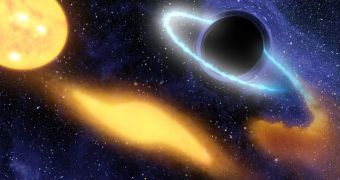All matter in the universe is characterized by a number called entropy, which measures the disorder inside an object. Probabilistic calculations reveal that all the stars in the universe might contribute with about 1E+79 units of entropy, or 1 followed by 79 zeros, if you want. However, a recently published study shows that a single black hole may contribute with more disorder than all the stars in the universe.
In 1970, Stephen Hawking revealed that, against general belief, black holes emit radiation and, given enough time, they would probably slowly evaporate out of existence. At the same time, he showed that the surface area of the event horizon is in direct relation with the black hole's entropy, which gives an idea of the disorder state inside it.
This practically means that a supermassive black hole, such as those found in the galactic nuclei, could have an entropy of about 1E+91, or 1 followed by 91 zeros, which is roughly equivalent to about a trillion times that of all the stars in the universe, and the total entropy of the universe could be at least 1E+102. Paul Frampton from the University of North Carolina, one of the authors of the study, approximates this massive number to be close to all the possible combinations of matter in the universe, which is about 2E+1E+102.
But there is one little problem. The vast majority of black holes population is though to have originated from the collapsed cores of dead stars, and stars cannot possibly contain such a high level of disorder. Why is that experienced in the black holes, and what phenomenon triggers it? Paul Frampton believes that this is a property associated to the random movement of particles in quantum physics. As the central core of the star collapses, it passes through a phase in which it is transformed into an object with a maximum matter disorder, where particles move in random ways at extremely high speeds.
Calculations show that such 'monster' states would in fact be extremely rare, and cannot be directly observed due to the unique features of the black holes. It is believed that the matter inside black holes mostly follow quantum mechanics rules, thus, while calculating the entropy of such an object, one must take into consideration the "monster's" entropy, as quantum mechanics represents all the possible outcomes of a process.
The existence of such objects and understanding the entropy of a black hole may lead to a better theory for gravity which could be linked with the quantum gravitation theory, in order to spawn the so-called 'Theory of Everything' which would basically be an image of the whole universe, as it was, is and will be.
Skeptics where soon to follow, arguing that the study conducted by the team from the University of North California did not use the best theoretical tools while trying to explain the entropy of a black hole.

 14 DAY TRIAL //
14 DAY TRIAL //